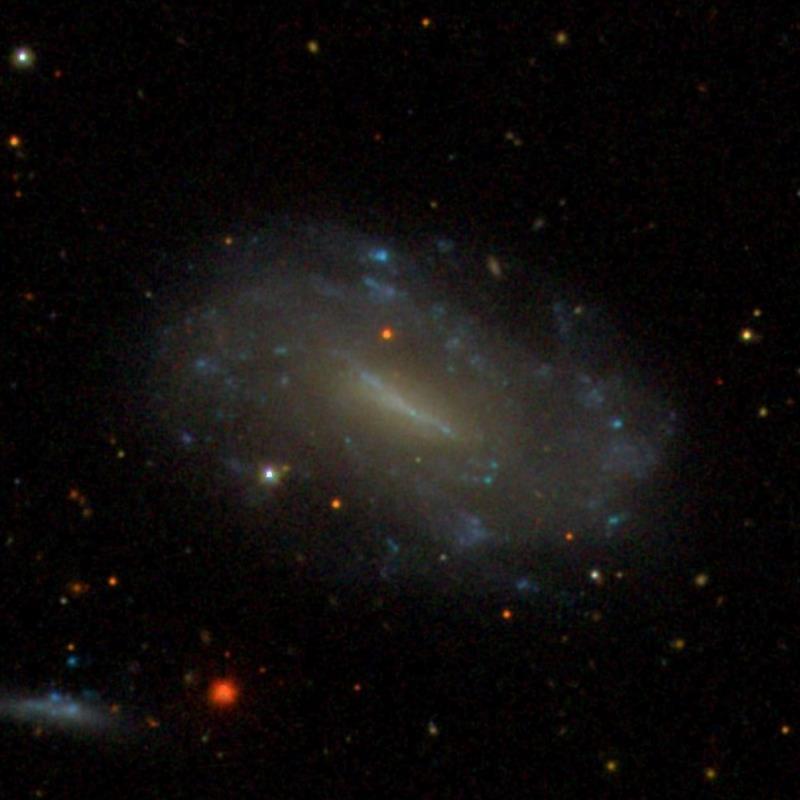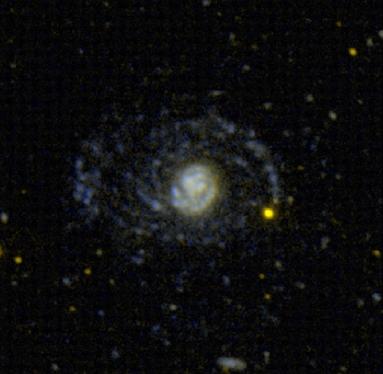|
NGC 5713
NGC 5713 is a peculiar, asymmetric galaxy in the constellation Virgo. Although classified as a spiral galaxy by most galaxy catalogs, NGC 5713 is very different from most normal spiral galaxies. While most spiral galaxies either have either two well-defined spiral arms or a filamentary spiral-like structure, this spiral galaxy has only one visible spiral arm in its disk. This makes it a galaxy of the Magellanic type. Gravitational interactions with the nearby spiral galaxy NGC 5719 may be responsible for producing the disturbed, asymmetric structure including the single spiral arm. NGC 5713 is at the center of a small group of spiral galaxies that also includes NGC 5691, NGC 5705, and NGC 5719. It is a member of the NGC 5746 Group of galaxies, itself one of the Virgo III Groups strung out to the east of the Virgo Supercluster of galaxies. Star formation Compared to many other nearby spiral galaxies, NGC 5713 appears to be a site of relatively intense star formation a ... [...More Info...] [...Related Items...] OR: [Wikipedia] [Google] [Baidu] |
New General Catalogue
The ''New General Catalogue of Nebulae and Clusters of Stars'' (abbreviated NGC) is an astronomical catalogue of deep-sky objects compiled by John Louis Emil Dreyer in 1888. The NGC contains 7,840 objects, including galaxies, star clusters and emission nebulae. Dreyer published two supplements to the NGC in 1895 and 1908, known as the ''Index Catalogues'' (abbreviated IC), describing a further 5,386 astronomical objects. Thousands of these objects are best known by their NGC or IC numbers, which remain in widespread use. The NGC expanded and consolidated the cataloguing work of William and Caroline Herschel, and John Herschel's ''General Catalogue of Nebulae and Clusters of Stars''. Objects south of the celestial equator are catalogued somewhat less thoroughly, but many were included based on observation by John Herschel or James Dunlop. The NGC contained multiple errors, but attempts to eliminate them were made by the ''Revised New General Catalogue'' (RNGC) by Jack W. Sulent ... [...More Info...] [...Related Items...] OR: [Wikipedia] [Google] [Baidu] |
NGC 5705
NGC 5705 is a spiral galaxy in the constellation Virgo. NGC 5705 is part of a small group of spiral galaxies that also includes NGC 5691, NGC 5713, and NGC 5719. It is a member of the NGC 5746 Group of galaxies, itself one of the Virgo III Groups strung out to the east of the Virgo Supercluster The Virgo Supercluster (Virgo SC) or the Local Supercluster (LSC or LS) is a mass concentration of galaxies containing the Virgo Cluster and Local Group, which itself contains the Milky Way and Andromeda galaxies, as well as others. At least ... of galaxies. References External links * Barred spiral galaxies 5705 52395 09447 Virgo (constellation) {{Spiral-galaxy-stub ... [...More Info...] [...Related Items...] OR: [Wikipedia] [Google] [Baidu] |
UGC Objects
UGC may refer to: Science and technology * Universal gravitational constant G, in physics * Uppsala General Catalogue, an astronomical catalogue of galaxies * UGC, a codon for cysteine * Unique games conjecture In computational complexity theory, the unique games conjecture (often referred to as UGC) is a conjecture made by Subhash Khot in 2002. The conjecture postulates that the problem of determining the approximate ''value'' of a certain type of gam ..., a conjecture in computational complexity Organisations * UGC (cinema operator), a European cinema chain, formerly Union Générale Cinématographique * UGC Fox Distribution, a former French-American film production company formed in 1995 * Union Graduate College, Schenectady, New York * United Grain Company, a Russian grain trading company based in Moscow * University Grants Commission (other) * University Grants Committee (other) * UnitedGlobalCom, former name of the cable TV operator Liberty Global * Un ... [...More Info...] [...Related Items...] OR: [Wikipedia] [Google] [Baidu] |
NGC Objects
The ''New General Catalogue of Nebulae and Clusters of Stars'' (abbreviated NGC) is an astronomical catalogue of deep-sky objects compiled by John Louis Emil Dreyer in 1888. The NGC contains 7,840 objects, including galaxies, star clusters and emission nebulae. Dreyer published two supplements to the NGC in 1895 and 1908, known as the ''Index Catalogues'' (abbreviated IC), describing a further 5,386 astronomical objects. Thousands of these objects are best known by their NGC or IC numbers, which remain in widespread use. The NGC expanded and consolidated the cataloguing work of William and Caroline Herschel, and John Herschel's ''General Catalogue of Nebulae and Clusters of Stars''. Objects south of the celestial equator are catalogued somewhat less thoroughly, but many were included based on observation by John Herschel or James Dunlop. The NGC contained multiple errors, but attempts to eliminate them were made by the ''Revised New General Catalogue'' (RNGC) by Jack W. Sulenti ... [...More Info...] [...Related Items...] OR: [Wikipedia] [Google] [Baidu] |
Peculiar Galaxies
A peculiar galaxy is a galaxy of unusual size, shape, or composition. Between five and ten percent of known galaxies are categorized as peculiar. Astronomers have identified two types of peculiar galaxies: ''interacting galaxies'' and ''active galactic nuclei'' (AGN). When two galaxies come close to each other, their mutual gravitational forces can cause them to acquire highly irregular shapes. The terms 'peculiar galaxy' and 'interacting galaxy' have now become synonymous because the majority of peculiar galaxies attribute their forms to such gravitational forces. Formation Scientists hypothesize that many peculiar galaxies are formed by the collision of two or more galaxies. As such, peculiar galaxies tend to host more active galactic nuclei than normal galaxies, indicating that they contain supermassive black holes. Many peculiar galaxies experience starbursts, or episodes of rapid star formation, due to the galaxies merging. The periods of elevated star formation and the l ... [...More Info...] [...Related Items...] OR: [Wikipedia] [Google] [Baidu] |
Unbarred Spiral Galaxies
A barred spiral galaxy is a spiral galaxy with a central bar-shaped structure composed of stars. Bars are found in about two thirds of all spiral galaxies, and generally affect both the motions of stars and interstellar gas within spiral galaxies and can affect spiral arms as well. The Milky Way Galaxy, where the Solar System is located, is classified as a barred spiral galaxy. Edwin Hubble classified spiral galaxies of this type as "SB" (spiral, barred) in his Hubble sequence and arranged them into sub-categories based on how open the arms of the spiral are. SBa types feature tightly bound arms, while SBc types are at the other extreme and have loosely bound arms. SBb-type galaxies lie in between the two. SB0 is a barred lenticular galaxy. A new type, SBm, was subsequently created to describe somewhat irregular barred spirals, such as the Magellanic Clouds, which were once classified as irregular galaxies, but have since been found to contain barred spiral structures. Among othe ... [...More Info...] [...Related Items...] OR: [Wikipedia] [Google] [Baidu] |
NGC 4625
NGC 4625 is a distorted dwarf galaxy in the constellation Canes Venatici. The galaxy is formally classified as a Sm galaxy, which means that its structure vaguely resembles the structure of spiral galaxies. The galaxy is sometimes referred to as a Magellanic spiral because of its resemblance to the Magellanic clouds. Structure Unlike most spiral galaxies, NGC 4625 has a single spiral arm, which gives the galaxy an asymmetric appearance. It has been hypothesized that this galaxy's asymmetric structure may be the result of a gravitational interaction with NGC 4618. Such asymmetric structure is commonly seen among many interacting galaxies. However, observations of neutral hydrogen gas in NGC 4618 and NGC 4625 show that NGC 4625 does not appear to have been affected by the gravitational interaction. This indicates that the single-arm structure seen in NGC 4625 may be created through intrinsic processes. Ultraviolet observations of NGC 4625 made by the Galaxy Evolution Exp ... [...More Info...] [...Related Items...] OR: [Wikipedia] [Google] [Baidu] |
NGC 4618
NGC 4618 is a distorted barred dwarf galaxy in the constellation Canes Venatici. The galaxy is formally classified as a Sm galaxy, which means that its structure vaguely resembles the structure of spiral galaxies. The galaxy is sometimes referred to as a Magellanic spiral because of its resemblance to the Magellanic clouds. Structure Unlike most spiral galaxies, NGC 4618 has a single spiral arm, which gives the galaxy an asymmetric appearance. This galaxy was included in the ''Atlas of Peculiar Galaxies'' as one of three examples of nearby galaxies with single spiral arms. Although NGC 4618 is labeled as peculiar, many similar galaxies have been identified. It has been hypothesized that this galaxy's asymmetric structure may be the result of a gravitational interaction with NGC 4625. Such asymmetric structure is commonly seen among many interacting galaxies. However, observations of neutral hydrogen gas in NGC 4618 and NGC 4625 imply that only some of the gas outside the o ... [...More Info...] [...Related Items...] OR: [Wikipedia] [Google] [Baidu] |
Star Formation
Star formation is the process by which dense regions within molecular clouds in The "medium" is present further soon.-->interstellar space, sometimes referred to as "stellar nurseries" or "-forming regions", and form s. As a branch of , star formation includes the study of the |
Virgo Supercluster
The Virgo Supercluster (Virgo SC) or the Local Supercluster (LSC or LS) is a mass concentration of galaxies containing the Virgo Cluster and Local Group, which itself contains the Milky Way and Andromeda galaxies, as well as others. At least 100 galaxy groups and clusters are located within its diameter of 33 megaparsecs (110 million light-years). The Virgo SC is one of about 10 million superclusters in the observable universe and is in the Pisces–Cetus Supercluster Complex, a galaxy filament. A 2014 study indicates that the Virgo Supercluster is only a lobe of an even greater supercluster, Laniakea, a larger, competing referent of the term Local Supercluster centered on the Great Attractor. Background Beginning with the first large sample of nebulae published by William and John Herschel in 1863, it was known that there is a marked excess of nebular fields in the constellation Virgo (near the north galactic pole). In the 1950s, French–American astronomer Gérard de Vau ... [...More Info...] [...Related Items...] OR: [Wikipedia] [Google] [Baidu] |
Virgo III Groups
The Virgo III Groups, or Virgo III Cloud, are a series of at least 75 galactic clusters and individual galaxies stretching approximately off the eastern edge of the Virgo Supercluster. Parts of it are in the constellations Virgo, Libra, and Serpens Caput. It is located approximately to from the Solar System, at a right ascension of to . These clusters include: * NGC 5248 Group: ** NGC 5248 ** UGC 8575 ** UGC 8614 * NGC 5364 Group: ** NGC 5300 ** NGC 5348 ** NGC 5356 ** NGC 5360 ** NGC 5363 ** NGC 5364 * NGC 5506 Group: ** IC 976 ** NGC 5496 ** NGC 5506 ** NGC 5507 ** UGC 9057 * NGC 5566 Group: ** NGC 5560 ** NGC 5566 ** NGC 5569 ** NGC 5574 ** NGC 5576 ** NGC 5577 ** UGC 9215 * NGC 5638 Group: ** IC 1024 ** NGC 5636 ** NGC 5638 ** NGC 5668 ** UGC 9310 ** UGC 9380 * NGC 5746 Group: ** NGC 5658 ** NGC 5690 ** NGC 5691 ** NGC 5692 ** NGC 5705 **NGC 5713 ** NGC 5719 ** NGC 5725 ** NGC 5740 ** NGC 5746 ** NGC 5750 ** UGC 9299 ** UGC 9469 ** UGC 9482 * NGC 5775 Group: ** IC 1066 ** ... [...More Info...] [...Related Items...] OR: [Wikipedia] [Google] [Baidu] |






